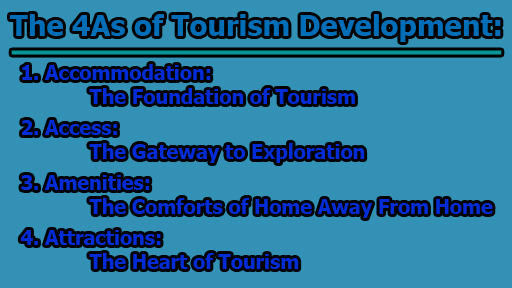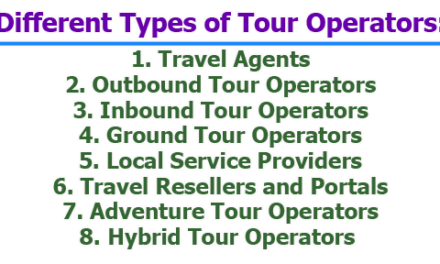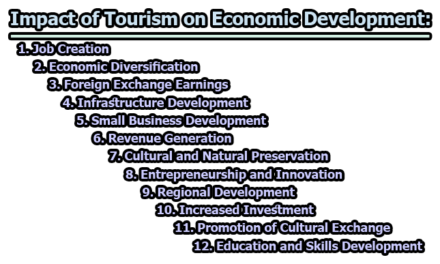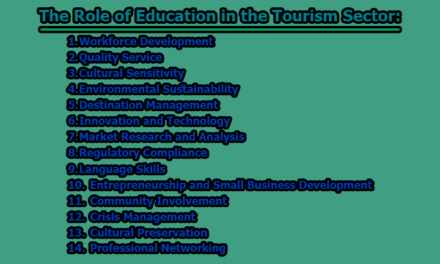The 4As of Tourism Development:
Tourism is a global phenomenon that has gained significant momentum over the years. People from different corners of the world are constantly seeking unique experiences, pristine locations, and opportunities to immerse themselves in diverse cultures. For these wanderlust-driven individuals, destinations must offer a blend of exceptional components to become a hot spot. In the world of tourism management, these components are often referred to as the 4As of tourism development: Accommodation, Access, Amenities, and Attractions. Understanding and optimizing these four key elements is paramount for creating a successful destination that meets the quality and requirements of visitors. In this article, we will delve into each of the 4As and explore how tourism managers should consider them in the development of a destination.
1. Accommodation: The Foundation of Tourism:
Accommodation is the first pillar of the 4As in tourism development. It sets the stage for visitors and plays a vital role in shaping their experiences. Think of it as the foundation upon which your destination’s tourism industry is built. Here’s why it’s so crucial:
a) Variety of Options: To cater to a diverse range of travelers, accommodation options should be abundant and varied. From luxury resorts to budget hostels, and everything in between, tourists should have choices that suit their preferences and budgets.
b) Quality Standards: Accommodation facilities should meet international quality standards. Cleanliness, safety, and comfort are non-negotiable factors. Travelers expect their stay to be a pleasant one, and this starts with where they rest their heads.
c) Local Flavor: Some tourists seek an authentic experience. This can be provided by accommodations that reflect the local culture and architecture. Whether it’s a traditional guesthouse or a modern eco-lodge, the accommodations should integrate with the destination’s identity.
d) Accessibility: Proximity to key attractions and transportation hubs is essential. Visitors should be able to easily reach their chosen accommodation, which often involves factors like good road networks, proximity to airports or train stations, and efficient public transportation.
e) Sustainability: In an era where eco-consciousness is on the rise, sustainable and eco-friendly accommodations are increasingly popular. These options not only attract a specific segment of travelers but also help in preserving the natural beauty of the destination.
2. Access: The Gateway to Exploration:
The second ‘A’ in the 4As of tourism development is Access. A destination’s accessibility is fundamental in attracting tourists. Whether your location is a hidden gem or a popular destination, it needs to be easily reachable to lure travelers. Here’s how it plays a pivotal role:
a) Transportation Infrastructure: Well-connected destinations have an edge. This includes a combination of air travel, road networks, railways, and maritime options. Efficient transportation infrastructure ensures that visitors can reach your destination without major hassles.
b) Air Connectivity: Airports play a significant role in attracting international tourists. Direct flights or convenient layovers in major hubs can make a destination far more appealing. It’s often a deciding factor for travelers, especially when they come from distant corners of the world.
c) Visa and Entry Policies: Clear and straightforward visa policies, as well as entry and exit procedures, can significantly impact a destination’s accessibility. Streamlined immigration processes can encourage more people to visit.
d) Safety: The perception of safety is crucial. Tourists want to know that they can travel to and within a destination without worrying about security issues. Developing a reputation for safety can be a major selling point.
e) Local Transportation: Once visitors arrive, they need efficient local transportation to explore the area. Whether it’s buses, trams, taxis, or ridesharing services, convenient local transit options are vital.
3. Amenities: The Comforts of Home Away From Home:
Amenities are the third key component in the 4As of tourism development. They encompass the services and facilities that tourists require during their stay. These are the comforts and conveniences that make a destination enjoyable and memorable:
a) Dining Options: Varied and high-quality dining experiences are a must. This includes a range of restaurants, cafes, street food stalls, and local delicacies. Catering to different tastes, dietary requirements, and budgets is essential.
b) Shopping: Tourists often enjoy souvenir shopping, and destinations can create vibrant marketplaces to cater to these needs. Markets, boutiques, and artisan shops add a unique flavor to a location.
c) Healthcare Facilities: Access to healthcare services is crucial. Tourists need to know that medical facilities, pharmacies, and emergency services are available in case of need.
d) Communication and Connectivity: In our modern world, staying connected is a top priority for travelers. Providing reliable internet access, local SIM cards, and Wi-Fi in public spaces is expected.
e) Recreation and Entertainment: Amenities such as theaters, sports facilities, parks, and cultural events offer tourists opportunities to relax and be entertained during their stay.
f) Tourist Information Centers: These centers offer valuable resources like maps, brochures, and knowledgeable staff who can provide guidance and recommendations.
4. Attractions: The Heart of Tourism:
Attractions are the crown jewel of tourism development. These are the sites, experiences, and activities that draw visitors to your destination. Understanding the unique appeal of your location and capitalizing on it is essential:
a) Natural Wonders: Destinations often feature unique natural attractions such as beaches, mountains, forests, waterfalls, and wildlife. Preservation and accessibility of these wonders are key.
b) Cultural Heritage: Historical sites, museums, art galleries, and cultural festivals showcase the rich heritage of a place. These attractions allow tourists to immerse themselves in the local culture.
c) Adventure and Sports: For the adventure-seeking crowd, activities like trekking, scuba diving, and extreme sports can be a significant draw. Offering well-organized adventure packages can be a big selling point.
d) Events and Festivals: Hosting events and festivals can attract visitors during specific seasons. These gatherings often offer unique insights into local traditions and customs.
e) Hospitality and Service Quality: The way tourists are received and treated can also be a major attraction. Warm, friendly, and efficient service can leave a lasting impression.
The Interconnectedness of the 4As:
While we have discussed each of the 4As individually, it’s important to note that they are interconnected and influence each other. For example:
- A lack of proper accommodation options can hinder the growth of a destination, as tourists may avoid visiting due to concerns about where to stay.
- Limited access to a destination, whether due to poor transportation infrastructure or visa complexities, can deter potential travelers.
- Without a solid foundation in accommodation and access, amenities and attractions may not reach their full potential. If tourists cannot comfortably reach and stay at a destination, they won’t be able to enjoy its amenities and attractions fully.
- A destination with a reputation for poor amenities may not be able to capitalize on its attractions, as tourists may leave unsatisfied due to a lack of essential services.
- Finally, attractions and amenities go hand-in-hand. To maximize the appeal of a tourist attraction, the surrounding amenities should be developed to cater to the needs and preferences of visitors.
Case Studies: Exemplary Destinations:
To further illustrate the significance of the 4As in tourism development, let’s examine a few case studies of destinations that have successfully leveraged these components.
Case Study 1: Bali, Indonesia:
Accommodation: Bali offers a wide range of accommodation options, from budget hostels for backpackers to luxurious villas and resorts. Many of these accommodations embrace traditional Balinese architecture and design, giving visitors a sense of cultural immersion.
Access: Ngurah Rai International Airport in Bali connects the island to major international cities. Efficient transportation services, such as taxis and ride-sharing apps, provide hassle-free access to different parts of the island.
Amenities: Bali boasts a diverse culinary scene, with local street food stalls, beachside cafes, and high-end restaurants serving international and Indonesian cuisine. There is also an abundance of shops selling traditional crafts and souvenirs.
Attractions: Bali’s natural beauty, including stunning beaches, lush rice terraces, and iconic temples, draws tourists from around the world. The island is also known for its vibrant culture, with frequent ceremonies and festivals that tourists can participate in.
Case Study 2: Dubai, UAE:
Accommodation: Dubai is synonymous with luxury, and its accommodation options reflect this image. From opulent hotels like the Burj Al Arab to high-end resorts, Dubai caters to travelers seeking extravagance.
Access: Dubai International Airport is a major global hub, connecting travelers to numerous destinations. The city’s modern road infrastructure, efficient public transportation, and user-friendly immigration processes make access easy.
Amenities: Dubai is a shopper’s paradise with its mega malls and traditional souks. The city offers top-notch healthcare services, and it is a global business hub with excellent communication and connectivity options.
Attractions: Dubai’s attractions include iconic landmarks like the Burj Khalifa, Palm Jumeirah, and the Dubai Fountain. The city is also known for its year-round events, including the Dubai Shopping Festival and Dubai Expo.
Case Study 3: New Zealand:
Accommodation: New Zealand offers a wide variety of accommodations, from charming bed-and-breakfasts to luxury lodges. Many of these accommodations are nestled amidst the stunning landscapes, providing visitors with unparalleled natural experiences.
Access: New Zealand has well-developed transportation infrastructure, with airports in major cities and a network of well-maintained roads. The country’s visa policies are straightforward and visitor-friendly.
Amenities: In addition to standard amenities, New Zealand provides ample opportunities for adventure, such as bungee jumping, hiking, and water sports. Tourist information centers are readily available to assist travelers.
Attractions: New Zealand’s attractions are centered around its breathtaking natural beauty, including fjords, geothermal wonders, and snow-capped mountains. The country is a paradise for outdoor enthusiasts, with activities like exploring the Fiordland, visiting the Hobbiton movie set, and experiencing Maori culture.
Case Study 4: Santorini, Greece:
Accommodation: Santorini is famous for its unique cave-style hotels and boutique accommodations that blend seamlessly with the island’s stunning architecture. Visitors often choose to stay in traditional whitewashed buildings with panoramic views.
Access: Santorini is accessible via direct flights or ferry services from Athens and other Greek islands. Local transportation is mainly by rental cars, scooters, or public buses.
Amenities: The island boasts a variety of charming restaurants serving Mediterranean cuisine and local specialties. Small boutiques, art galleries, and wineries offer unique shopping experiences.
Attractions: Santorini’s allure lies in its stunning sunsets, crystal-clear waters, and unique geological features. Iconic destinations include Oia, Fira, and the ancient ruins of Akrotiri. These attractions are complemented by the island’s relaxed and romantic atmosphere.
In conclusion, in the world of tourism management, creating a successful destination is an art that combines the four essential components of Accommodation, Access, Amenities, and Attractions. While each of these components can be seen individually, they are intrinsically interconnected. A destination’s accessibility and accommodation options shape its potential, which is then realized through the provision of quality amenities and the allure of attractions.
Understanding the unique character and potential of a destination is crucial for tourism managers. By focusing on the 4As, they can develop and maintain an environment that not only meets but exceeds the quality and requirements of visitors. Whether you’re planning to create a new tourist hotspot or revitalize an existing one, keep in mind the significance of these four pillars, as they hold the key to turning your destination into a dream location for travelers from all over the world.

Assistant Teacher at Zinzira Pir Mohammad Pilot School and College










